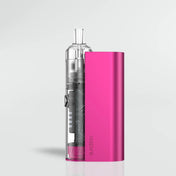The risks of second-hand smoke from cigarettes are widely understood at this point in history. Many of the dangers we know cigarettes present: lung disease, cancers, and heart problems to name just a few, are almost as likely to affect someone who regularly breathes in second-hand smoke as they are the smokers themselves. This risk is because, whether second-hand or not, tobacco smoke contains thousands of harmful and carcinogenic compounds alongside the nicotine we actually crave.
How then does vaping compare? Public Health England stated in 2015 that e-cigarette vapour contains on average 95% fewer harmful compounds than cigarette smoke. While this is of course going to reduce the level of risk inhaling vapour poses, it is still maintained that vaping is not risk-free. Because of the perceived safety of vaping products vs cigarettes, many people freely vape around others. These people inhaling second-hand vapour, while not necessarily being happy about it, will likely be less concerned about breathing it in than they would tobacco smoke.
Is this a fair assumption? How much of a risk does second-hand vapour actually pose, and how could this be reduced? The reality is that there are still limited studies and evidence comparing cigarette smoke to vapour, and even fewer focussing on the impacts of second-hand vaping. Read on however as we explore the available facts so you can vape responsibly and with some peace of mind.
Is E-Cig Vapour as Bad as Cigarette Smoke?
The short answer here is no, but that does not mean vaping gets a free pass. Despite not containing the thousands of carcinogenic nasties of tobacco smoke, e-cigarette vapour has been proven to contain enough to warrant caution.
It is worth noting that of the few studies available, much of the data is based on experiments from the USA. The differences between UK and USA vaping regulations means certain chemicals are permitted in flavourings across the pond that are banned here in Britain. This means that some of the claims about second-hand vapour are based on examples that contain traces of ingredients not used in the UK, and therefore UK vapers should note that the risk will be slightly reduced by comparison.
It has been noted that exhaled e-cigarette aerosol contains nicotine, propylene glycol, glycerol, particulate matter, ultra-fine particles, and volatile organic compounds (VOCs). While the latter may sound a little scary, these are just elements of the flavourings used in any given e-liquid, given their scientific classification.
While some of these elements are not harmful, a study conducted in Maryland, USA, assessed the indoor air quality of a vaping convention. Anyone who has been to a vaping convention here in the UK will know – there are a LOT of vapers creating a LOT of clouds. So, we must remember that this is a particularly extreme case study. Regardless, the study found that the air quality was negatively impacted because of the second-hand vapour present. Stating that: “The large number of people using e-cigarettes indoors at vaping conventions may increase health risks among attendees and convention workers.”
There are no published studies on the health effects of second-hand e-cig vapour, but existing environmental evidence tells us that adverse effects can occur from both long and short-term exposure to any particulates. This includes those that were found to be in the exhaled vapour at the convention.
The primary issue identified by all the available studies is that second-hand vapour exposes potential non-smokers to the same levels of nicotine that they would inhale via second-hand cigarette smoke. The Maryland study found that “The average indoor nicotine concentration of 124.7 μg/m3 in our study was similar to second-hand smoke nicotine measured in nightclubs and pubs when cigarette smoking was permitted in the US and Canada”.
A separate study flagged the same issue, stating “There’s evidence that non-smokers exposed to second-hand vape aerosol absorb similar levels of nicotine as people exposed to second-hand cigarette smoke. Along with nicotine, non-vapers are also exposed to ultrafine particles from second-hand vape aerosol, which may increase the risk of cardiovascular disease.”
The evidence is still relatively limited, but the risk of nicotine exposure appears to be the biggest issue posed by second-hand vapour. Ultimately then the evidence we have suggests that cigarette smoke is far more harmful in general, but second-hand e-cig vapour carries it’s own risks, particularly the exposure to nicotine.
Who is Most at Risk?
Now we understand the reduced, but still present risk posed by second-hand vapour, it is easier to understand who would be most vulnerable to its effects. Much in the same way cigarette smoke poses the greatest threat to the most vulnerable, vapers should be careful not to vape around:
- The elderly
- The young (infants and children)
- Pregnant Women
- Those with underlying cardiovascular, pulmonary, or respiratory illness e.g. Asthma/Bronchitis
- Those with adverse reactions to nicotine
While it may seem obvious, take care to avoid excessive vaping if you are around any of the above people, or especially if any of the categories apply to you.
How to Vape Responsibly
If you are concerned about protecting others from any risk posed by second-hand vapour, there are some simple common-sense things you can do to reduce your impact.
- Vape outdoors – the ventilation will prevent dense second-hand clouds hanging around.
- Avoid high-risk people – consider the section above and act accordingly to keep people safe.
- Use lower nicotine strength products – if avoiding indoor vaping is hard, reduce the risk by reducing the concentration of nicotine you will be exhaling.
- Choose a device with lower power output – smaller 50-50 devices like the EDGE GO will mean you simply cannot produce the massive clouds that pose the biggest risk.
Follow the advice given here and you will be vaping more responsibly – it’s up to us as vapers to look out for each other and make sure our habits don’t hurt those around us.
Our Sources:



